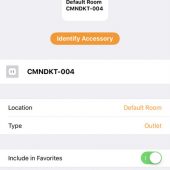Attempting to set up a smart home through Apple’s HomeKit should be fairly simple, right? You have specific appliances and gadget that only work with this feature, but what if they don’t really… work?

Well, that’s a case of what happened with me with Incipio’s CommandKit Wireless Smart Outlet With Monitoring adapter. At $39.99, it’s modestly priced, and with a brand like Incipio, you typically get a high-quality product that is built to last immediately after unboxing. And then, there’s the CommandKit Smart Outlet.
I had the opportunity to review the CommandKit Outlet by Incipio and from start to finish, the process hadn’t been a great one. The “smart outlet” was one of the first on the market to be fully compatible with Apple’s HomeKit, which is a big deal because Apple puts anything they attach their names to through a critical review process. You have to figure, there are products like the Ecobee3 which took roughly a year to integrate into HomeKit and getting certified requires two types of MFi licenses in order to even be considered by Apple: A developer license, and a manufacturer’s license. After that, you get audited by Apple to ensure you meet the requirements it takes to install a special authorizing chip that Apple supplies directly. So that being said, a company like Incipio should have a product that are ready from the beginning for us Apple HomeKit lovers right? It can be, but the setup is a BIT tedious.

The CommandKit’s whole premise is to actually make controlling the devices in your home such as lamps, bluetooth speakers, and other household items at all times. If you’re on the go and forget to turn off the coffee pot, the CommandKit is supposed to be there in order to get things done for you. And it shouldn’t take you more than five minutes to actually get the CommandKit to work for you. With the companion app in the app store, setup should be as quick as downloading the app, but it’s not, to the point I actually used Apple’s own “Home” app to set up instead. So let’s get into it:
For starters, the CommandKit’s app, although updated recently, it seems to be stuck in the iOS7 days in terms of wasted retail space. In comparison to Apples San Francisco font which is a lot easier on the eyes, the CommandKit app seems to be a bit all over the place, with large fonts everywhere, and only arrows and plus signs showing you in the direction you need to go in order to get back a menu, or to add to the screen you are currently on. So if you want to save yourself the hassle, use the setup from the Home app included by Apple.

This will require you first to actually unbox the CommandKit Smart Outlet and plug it into the wall (if you haven’t done this already). The Smart Outlet itself is actually really cool after unboxing. It’s a simple white oval outlet which will stick out from your standard wall outlet roughly two inches once plugged in. It’s not the smallest outlet on the market in term of width either, and I personally suggest putting it at the bottom of the two outlets in your wall. If you have things like an Apple iPad charger brick, or another brick taking over the standard top outlet, be prepared for them to fit VERY snug together.

On the side of the device is a power button that is used to power on/off the device when you cannot access your phone, and it will still sync to your Home/CommandKit app.
At the top of the device, there’s Incipit’s infamous logo while at the bottom of the device is the unique HomeKit code you can actually scan into Apple’s Home app for faster syncing. This method worked for me perfectly.
Once you’ve actually gone and figured out this process, not only will the CommandKit Smart Outlet be connected through Apple’s app, but through Incipit’s own CommandKit app which is pretty nice because now you can use one or both features to set up triggers and scenes based on your location. For example, you can actually set the CommandKit to turn on and off once you’ve gotten a far enough distance from your home, or even set the lights to turn on when you are 10-15 feet away from your front door. In a better case, you can even set a schedule or scene that will trigger as well, such as turning your coffee pot on so it’s ready for brewing.
It’s taken a bit to get used to Incipio’s CommandKit, but over the past week or so it’s becoming something I actually do enjoy in my smart home after a shaky setup to begin with. While I don’t have many other HomeKit products (mainly due to Apple limiting how many they’re truly are), it is awesome to tell Siri “Siri, turn my lights offs in the living room”, and get a response that they are indeed off. Although this means you have to keep your light switch turned on at all times, one thing I wish the Incipio has was ability to measure how much power was being saved by using this. This would be a great help.
Overall, if you are looking for a way to get into starting a smart home, other than obviously fancy smart lamps, I would suggest starting with a smart outlet, and at $39.99, it’s worth a shot trying with a trusted name like Incipio.
For more information about Incipio’s CommandKit Smart Outlet, you can head over to Incipio today.
Source: Manufacturer Supplied review unit
What I Like: Works flawlessly with HomeKit; location based triggers
What Needs Improvement: Outdated app font, somewhat bulky for an outlet









